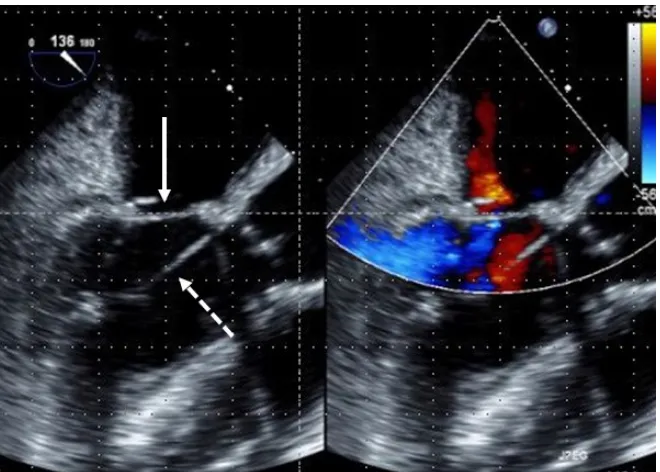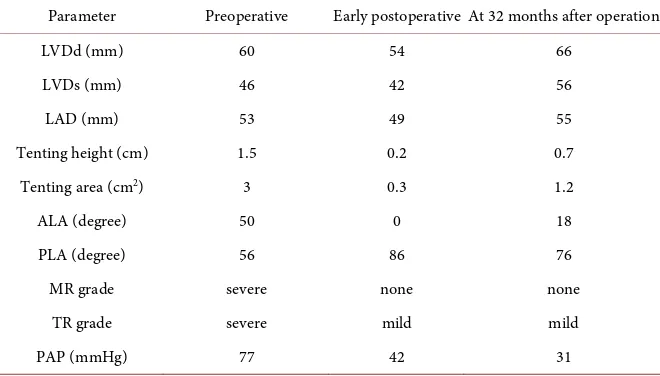http://www.scirp.org/journal/wjcs ISSN Online: 2164-3210
ISSN Print: 2164-3202
DOI: 10.4236/wjcs.2017.712017 Dec. 8, 2017 150 World Journal of Cardiovascular Surgery
Left Ventricular Reconstruction and Mitral
Valve Annuloplasty Combined with Papillary
Muscle Relocation for Severe Ischemic
Mitral Regurgitation
Koji Furukawa
1,2*, Mitsuhiro Yano
1, Eisaku Nakamura
2, Masakazu Matsuyama
1,
Masanori Nishimura
1, Katsuya Kawagoe
1, Kunihide Nakamura
21Department of Cardiovascular Surgery, Miyazaki Medical Association Hospital, Miyazaki, Japan 2Department of Cardiovascular Surgery, Faculty of Medicine, University of Miyazaki, Miyazaki, Japan
Abstract
A 46-year-old man was referred to our hospital due to severe ischemic mitral regurgitation with severe bileaflet tethering and a dilated left ventricle. We performed left ventricular reconstruction and mitral valve annuloplasty com-bined with papillary muscle relocation. Although left ventricular continued remodeling occurred during follow-up, left ventricular reconstruction and mitral valve annuloplasty combined with papillary muscle relocation provided durable mitral repair, and his functional status was good. Thus, this combined surgical treatment may reduce mitral regurgitation recurrence after mitral valve annuloplasty.
Keywords
Ischemic Mitral Regurgitation, Left Ventricular Reconstruction, Mitral Valve Annuloplasty, Papillary Muscle Relocation
1. Introduction
Mitral valve annuloplasty (MAP) has been the gold standard for surgical treat-ment of ischemic mitral regurgitation (IMR) [1]. However, high rates of persis-tence and/or recurrence of mitral regurgitation (MR) following MAP have been observed in patients with a dilated left ventricle (LV), and the surgical results of MAP have not been satisfactory. Recently, new and alternative surgical proce-dures that target the valvular, subvalvular, or ventricular levels have been at-How to cite this paper: Furukawa, K.,
Yano, M., Nakamura, E., Matsuyama, M., Nishimura, M., Kawagoe, K. and Nakamu-ra, K. (2017) Left Ventricular Reconstruc-tion and Mitral Valve Annuloplasty Com-bined with Papillary Muscle Relocation for Severe Ischemic Mitral Regurgitation. World Journal of Cardiovascular Surgery, 7, 150- 155.
https://doi.org/10.4236/wjcs.2017.712017
Received: November 4, 2017 Accepted: December 5, 2017 Published: December 8, 2017
Copyright © 2017 by authors and Scientific Research Publishing Inc. This work is licensed under the Creative Commons Attribution International License (CC BY 4.0).
DOI: 10.4236/wjcs.2017.712017 151 World Journal of Cardiovascular Surgery tempted to provide longer-lasting MR relief, and promising results are reported by some groups [2] [3] [4] [5] [6]. Herein, we report a case involving LV recon-struction (LVR) and MAP combined with papillary muscle relocation (PMR) for severe IMR.
2. Case Report
A 46-year-old man was transferred to our hospital with a diagnosis of congestive heart failure with severe IMR. He had undergone percutaneous coronary inter-vention for the proximal left descending artery due to an acute myocardial in-farction (MI) 6 months prior. A grade 2/6 pansystolic murmur was auscultated at the apex. His serum brain natriuretic peptide (BNP) level was 2598 pg/ml, and his functional status was New York Heart Association (NYHA) class IV. Trans-thoracic echocardiogram (TTE) demonstrated severe IMR with an MR volume of 63 ml, effective MR orifice area of 0.7 cm2, tenting height of 1.5 cm, tenting area of 3.0 cm2, anterior leaflet tethering angle (ALA) of 50˚, posterior leaflet te-thering angle (PLA) of 56˚, and severe tricuspid regurgitation with pulmonary hypertension (77 mmHg) (Table 1). Coronary angiography revealed no signifi-cant stenosis in any artery. Cardiac catheterization showed LV dilatation with akinesis at the mid-anterior wall to the apex, and fourth grade MR. The LV end-systolic volume index (LVESVI), LV ejection fraction (LVEF), pulmonary artery pressure, and pulmonary wedge pressure were 127 ml/m2, 20%, 68/37 mmHg, and 43 mmHg, respectively. Transesophageal echocardiogram (TEE) showed severe central MR with tethering of both leaflets; in particular, the ante-rior leaflet was tethered due to secondary chordae and its mobility was severely restricted (Figure 1).
DOI: 10.4236/wjcs.2017.712017 152 World Journal of Cardiovascular Surgery
Figure 1. Preoperative transesophageal echocardiogram showing central mitral regurgi-tation (asterisk) with tethering of both leaflets; in particular, the anterior leaflet was te-thered due to secondary chordae and its mobility was severely restricted (arrow).
Figure 2. Intra-operative transesophageal echocardiogram showing mitral closure due to improvement in the mobility of the anterior leaflet (arrow) and no mitral regurgitation. Dashed arrow indicates relocating suture.
[image:3.595.209.539.364.600.2]DOI: 10.4236/wjcs.2017.712017 153 World Journal of Cardiovascular Surgery
Table 1. Pre- and post-operative transthoracic echocardiograms parameters.
Parameter Preoperative Early postoperative At 32 months after operation
LVDd (mm) 60 54 66
LVDs (mm) 46 42 56
LAD (mm) 53 49 55
Tenting height (cm) 1.5 0.2 0.7
Tenting area (cm2) 3 0.3 1.2
ALA (degree) 50 0 18
PLA (degree) 56 86 76
MR grade severe none none
TR grade severe mild mild
PAP (mmHg) 77 42 31
LVDd: left ventricular diastolic dimension; LVDs: left ventricular systolic dimension; LAD: left atrium di-mension; ALA: anterior leaflet tethering angle; PLA: posterior leaflet tethering angle, MR mitral regurgita-tion, TR tricuspid regurgitaregurgita-tion, PAP pulmonary artery systolic pressure.
operative TTE parameters. At 32 months after the surgery, the LV and left atrium had re-dilated. However, the PLA, which had deteriorated mildly in the early postoperative phase, did not worsen further and the ALA improved; recur-rence of MR or pulmonary hypertension did not occur. His serum BNP level was 142 pg/ml and his functional status was NYHA class II.
3. Discussion
MAP has been the gold standard for surgical treatment of IMR [1]. However, high rates of persistence and/or recurrence of MR following MAP have been ob-served in patients with a dilated LV, because MAP may exaggerate posterior leaflet tethering and result in MR recurrence [7]. In general, symmetrical tether-ing after an anterior wall MI, which occurred in the present case, is more global-ly remodeled, spherical, and dysfunctional compared to asymmetrical tethering, which occurs mainly after an inferior wall MI; not only the posterior PM, but also the anterior PM, is displaced and the inter-papillary muscle distance in-creases. Consequently, the surgical results of MAP for symmetrical tethering are worse compared to those for asymmetrical tethering [8]. LVR for a dilated LV can improve mitral competence by reducing wall stress and decreasing the LV diameter. However, LV distortion may occur after LVR, exacerbating MR.
DOI: 10.4236/wjcs.2017.712017 154 World Journal of Cardiovascular Surgery considered [6].
PMR corrects tethering at the subvalvular level, relocating an outwardly and apically displaced PMs toward the mitral annulus [3]. The posterior PM is usually a target for relocation in asymmetrical tethering [3] [4]; however, both PMs are targets in symmetrical tethering [5] [10]. Relocation toward the anterior annulus may allow natural directional repositioning of the PMs [4], effectively reducing the distance between the anterior annulus and the displaced PMs [4] and improving the diastolic anterior mitral leaflet excursion [10]. An approach through the aortotomy enables relocation of the PMs without disturbing mitral chordae tendineae, while precisely avoiding aortic regurgitation [4].
In addition to the exaggeration of posterior leaflet tethering [7], non-im- provement in anterior leaflet tethering and continued LV remodeling are re-portedly associated with persistence and/or recurrence of MR following MAP [8] [11]. In the present case, continued LV remodeling occurred despite LVR [12]. However, the posterior leaflet tethering never became exaggerated and the ante-rior leaflet tethering improved. Consequently, good MR control was maintained during the 32 months of follow-up. PMR for IMR is reportedly associated with good control of MR [4] [5], reversals in LV remodeling [4] [5], and fewer car-diac-related events [5]. However, PMR does not directly stabilize the posterior LV wall to reverse LV remodeling, and it is unknown whether the non-stabili- zed posterior LV wall influences the development of late MR after PMR. More-over, long-term follow-up must be needed because our follow-up period may have been too short to determine the long-lasting efficacy of this combined sur-gical treatment for severe IMR.
4. Conclusion
We reported the surgical management of a patient with IMR, demonstrating that LVR and MAP combined with PMR is an effective procedure for severe bileaflet tethering and a dilated LV. Thus, this combined surgical treatment may reduce MR recurrence after MAP.
References
[1] Bolling, S.F., Deeb, G.M., Brunsting, L.A. and Bach, D.S. (1995) Early Outcome of Mitral Valve Reconstruction in Patients with End-Stage Cardiomyopathy. The Journal of Thoracic and Cardiovascular Surgery, 109, 676-683.
https://doi.org/10.1016/S0022-5223(95)70348-9
[2] de Varennes, B., Chaturvedi, R., Sidhu, S., Côté, A.V., Shan, W.L., Goyer, C., et al. (2009) Initial Results of Posterior Leaflet Extension for Severe Type IIIb Ischemic Mitral Regurgitation. Circulation, 119, 2837-2843.
https://doi.org/10.1161/CIRCULATIONAHA.108.831412
[3] Kron, I.L., Green, G.R. and Cope, J.T. (2002) Surgical Relocation of the Posterior Papillary Muscle in Chronic Ischemic Mitral Regurgitation. The Annals of Thoracic Surgery, 74, 600-601. https://doi.org/10.1016/S0003-4975(02)03749-9
Regurgi-DOI: 10.4236/wjcs.2017.712017 155 World Journal of Cardiovascular Surgery tation with Severe Leaflet Tethering. Circulation, 120, S85-S91.
https://doi.org/10.1161/CIRCULATIONAHA.108.840173
[5] Fattouch, K., Lancellotti, P., Castrovinci, S., Murana, G., Sampognaro, R., Corrado, E., et al. (2012) Papillary Muscle Relocation in Conjunction with Valve Annulop-lasty improve Repair Results in Severe Ischemic Mitral Regurgitation. The Journal of Thoracic and Cardiovascular Surgery, 143, 1352-1355.
https://doi.org/10.1016/j.jtcvs.2011.09.062
[6] Suma, H., Tanabe, H., Uejima, T., Isomura, T. and Horii, T. (2009) Surgical Ven-tricular Restoration Combined with Mitral Valve Procedure for Endstage Ischemic Cardiomyopathy. European Journal of Cardio-Thoracic Surgery, 36, 280-285. https://doi.org/10.1016/j.ejcts.2009.03.028
[7] Kuwahara, E., Otsuji, Y., Iguro, Y., Ueno, T., Zhu, F., Mizukami, N., et al. (2006) Mechanism of Recurrent/Persistent Ischemic/Functional Mitral Regurgitation in the Chronic Phase after Surgical Annuloplasty: Importance of Augmented Posterior Leaflet Tethering. Circulation, 114, I529-534.
https://doi.org/10.1161/CIRCULATIONAHA.105.000729
[8] Gelsomino, S., Lorusso, R., Caciolli, S., Capecchi, I., Rostagno, C., Chioccioli, M., et al. (2008) Insights on Left Ventricular and Valvular Mechanisms of Recurrent Ischemic Mitral Regurgitation after Restrictive Annuloplasty and Coronary Artery Bypass Grafting. The Journal of Thoracic and Cardiovascular Surgery, 136, 507-518. https://doi.org/10.1016/j.jtcvs.2008.03.027
[9] Isomura, T., Horii, T., Suma, H. and Buckberg, G.D., RESTORE Group (2006) Sep-tal Anterior Ventricular Exclusion Operation (Pacopexy) for Ischemic Dilated Car-diomyopathy: Treat Form Not Disease. European Journal of Cardio-Thoracic Sur-gery, 29, S245-S250. https://doi.org/10.1016/j.ejcts.2006.03.008
[10] Watanabe, T., Arai, H., Nagaoka, E., Oi, K., Hachimaru, T., Kuroki, H., et al. (2014) Influence of Procedural Differences on Mitral Valve Configuration after Surgical Repair for Functional Mitral Regurgitation: In Which Direction Should the Papil-lary Muscle Be Relocated? Journal of Cardiothoracic Surgery, 9, 185.
https://doi.org/10.1186/s13019-014-0185-6
[11] Hung, J., Papakostas, L., Tahta, S.A., Hardy, B.G., Bollen, B.A., Duran, C.M., et al. (2004) Mechanism of Recurrent Ischemicmitral Regurgitation after Annuloplasty: Continued LV Remodeling as a Moving Target. Circulation, 110, II85-II90. [12] Di Donato, M., Sabatier, M., Dor, V., Gensini, G.F., Toso, A., Maioli, M., et al.
(2001) Effects of the Dor Procedure on Left Ventricular Dimension and Shape and Geometric Correlates of Mitral Regurgitation One Year after Surgery. The Journal of Thoracic and Cardiovascular Surgery, 121, 91-96.

